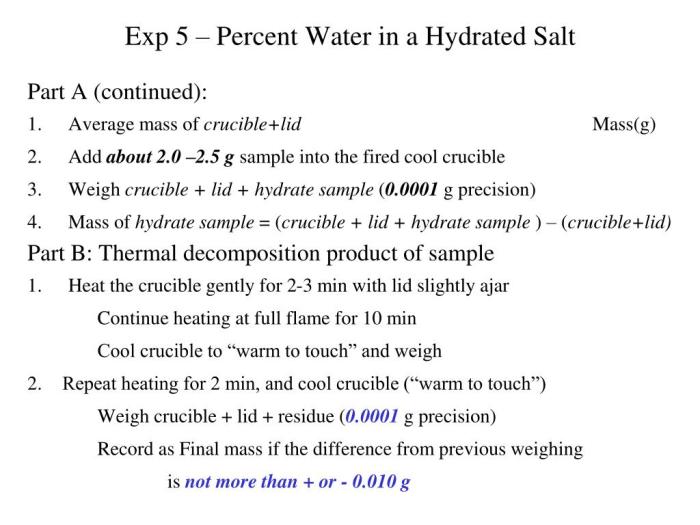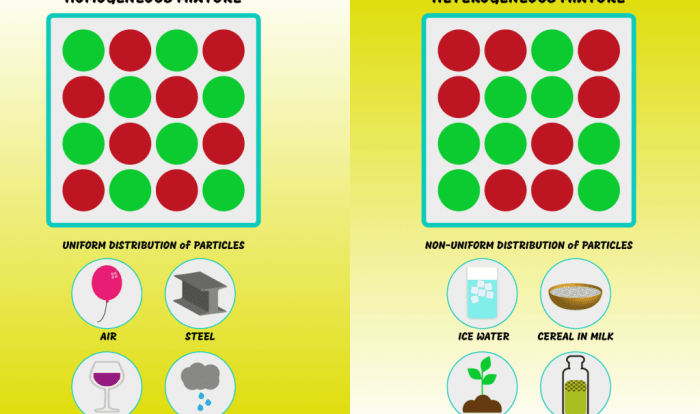Experiment 5 percent water in a hydrated salt delves into the fascinating realm of hydrated salts, exploring the impact of water content on their properties and uncovering potential applications for these unique materials.
Hydrated salts, with their intricate structures and diverse characteristics, play a significant role in various scientific and industrial processes. This experiment aims to shed light on the specific properties of hydrated salts containing 5% water, providing valuable insights into their behavior and potential uses.
1. Overview of Hydrated Salts

Hydrated salts are ionic compounds that contain water molecules as part of their crystal structure. These water molecules are held in place by electrostatic forces between the ions and the polar water molecules. Common examples of hydrated salts include sodium chloride (NaCl)·2H 2O, calcium chloride (CaCl 2)·2H 2O, and copper sulfate (CuSO 4)·5H 2O.
The water molecules in hydrated salts play a crucial role in determining their physical and chemical properties.
2. Impact of Water Content on Hydrated Salts

The amount of water in a hydrated salt has a significant impact on its properties. As the water content increases, the melting point of the salt decreases, and its solubility in water increases. This is because the water molecules interfere with the electrostatic forces between the ions, making it easier for them to break apart and dissolve in water.
Additionally, the color of a hydrated salt can change as the water content changes. For example, anhydrous copper sulfate is white, but when it is hydrated, it turns blue.
3. Experimental Analysis of 5% Water in a Hydrated Salt

To determine the properties of a hydrated salt with 5% water content, an experiment can be designed. This experiment could involve measuring the melting point, solubility, and color of the salt. The sample could be prepared by mixing the hydrated salt with a known amount of water and then heating it until all of the water has evaporated.
The melting point can be measured by placing the sample in a capillary tube and heating it until it melts. The solubility can be measured by dissolving the sample in a known volume of water and then measuring the concentration of the solution.
The color of the sample can be observed visually.
4. Comparison to Other Water Contents
The properties of a 5% hydrated salt can be compared to the properties of salts with different water contents. For example, the melting point of a 5% hydrated salt will be lower than the melting point of an anhydrous salt, and its solubility will be higher.
The color of a 5% hydrated salt may also be different from the color of an anhydrous salt. These differences in properties can be important for practical applications.
5. Applications of 5% Water Hydrated Salts: Experiment 5 Percent Water In A Hydrated Salt
Hydrated salts with 5% water content have a variety of potential applications. For example, they can be used as fertilizers, food additives, and pharmaceuticals. In the food industry, they are often used as anticaking agents to prevent clumping. In the pharmaceutical industry, they are used as binders and disintegrants in tablets and capsules.
Clarifying Questions
What is the significance of water content in hydrated salts?
Water content plays a crucial role in determining the physical and chemical properties of hydrated salts, influencing their solubility, reactivity, and stability.
How does the experiment determine the properties of a 5% hydrated salt?
The experiment involves designing a controlled environment, measuring various parameters, and analyzing the data to assess the specific properties of the 5% hydrated salt.
What are potential applications for 5% water hydrated salts?
Hydrated salts with 5% water content find applications in industries such as pharmaceuticals, food preservation, and chemical manufacturing, due to their unique properties and stability.
